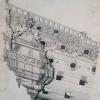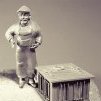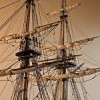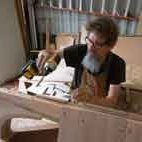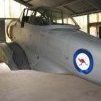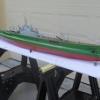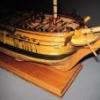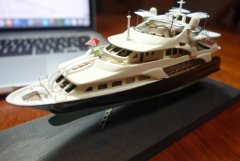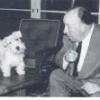MORE HANDBOOKS ARE ON THEIR WAY! We will let you know when they get here.
×
-
Posts
1,368 -
Joined
-
Last visited
Reputation Activity
-
 FriedClams got a reaction from Andrea Rossato in New England Stonington Dragger by FriedClams - FINISHED - 1:48 - POB
FriedClams got a reaction from Andrea Rossato in New England Stonington Dragger by FriedClams - FINISHED - 1:48 - POB
Thanks Keith
Lining OFF
Beginning the sawdust phase, I cut the bulkheads out with my scroll saw leaving the piece large (cutting to the outside of the template line.) I do this because I have no skill with the saw and cannot keep to a line. I then use a bench top disc sander and work back to the template outline. This works great with the convex edge and I use a Dremel sanding drum for the inside curves.
I glue these forms to the platform base and attach the keel/stem. Before the keel went on, I cut a rabbet on the stem.
Using a batten to see how the bulkheads faired, I found a problem. Station #8 was too small and #7 was ridiculously too large. Looking back at the body plan it’s hard to see how I missed it. But, that’s the point of going through the fairing up process. So, I built up #8 and went after #7 with a file.
Based on photos and drawings, the planking widths for this vessel seem to vary in the 5” to 7” range. I have a stash of stripwood that scales to approximately 6.5” wide x 1.75” thick so decided to use those. Because station #7 has the longest edge length of any bulkhead, it will be the location where the planks are at there full width. From here they taper to the stem and taper back to the stern. It will require 23 courses of planks per side.
There will be 4 belts per side of 6 planks each. Belt #1 beginning at the keel will have only 5. From station #7 back to the stern, 4 planks are lost in belt #1.
I measure the length of each station edge and check it against what my CAD drawing says it should be. Knowing how many planks will be required, I generate the following plank width tick mark strips for each bulkhead edge.
The width of the planks at the bow is just under 5.25” which satisfies the “not less than half” plank width guideline. No steelers or drops are needed.
The strip marks are temporarily taped on the bulkheads and a batten strip is used to get a general sense of the curve following the tick marks.
Happy with the way it looked, I transferred the tick marks to the stations with pencil and temporarily attached thread at each belt as a final check to see how the plank courses run. After a few minor modifications, I was ready to start planking.
Planking
The coloring and weathering the model will receive will not only reveal but also accentuate the planking on the hull, so I won’t be using any filler or putty. On a previous model, I planked the hull somewhat haphazardly, knowing that I was going to slather Bondo on it and sand it smooth. I’m happy with the way the model came out, but it would have been more realistic with the planks showing through the paint.
I set up a little jig to hold the stripwood firmly in place as I slice the taper into it - then sand to fit
I begin planking at the keel with the garboard and lay on two belts of planks on one side. Each course is tapered on the upper edge of the planks so that each successive course starts with a straight edge.
Each course of planks is made from a single strip of wood. After it is tapered and test fit, it is then cut to simulate the butt ends of two individual boards. The joints are reinforced on the reverse side.
Two more belts are added to the other side.
Then the last 4 belts are added minus the top three courses.
At this point, I cut the hull from the platform.
The next course of planking requires the scuppers.
Finally, I sand the hull and finish it off with a soft brass wire brush. The wire brush removes the sanding shine and any cross grain scratches and in general sort of unifies the look. It will also help with the weathering later on.
These final photos were taken in full direct sunlight in hopes that the effect of the wire brush can be seen. A few final licks with 800 grit paper will take the remaining wood fuzz off.
This post brings me up to date in real time on this model.
Thanks for taking a look.
Gary
-
 FriedClams got a reaction from Retired guy in New England Stonington Dragger by FriedClams - FINISHED - 1:48 - POB
FriedClams got a reaction from Retired guy in New England Stonington Dragger by FriedClams - FINISHED - 1:48 - POB
Thanks Keith
Lining OFF
Beginning the sawdust phase, I cut the bulkheads out with my scroll saw leaving the piece large (cutting to the outside of the template line.) I do this because I have no skill with the saw and cannot keep to a line. I then use a bench top disc sander and work back to the template outline. This works great with the convex edge and I use a Dremel sanding drum for the inside curves.
I glue these forms to the platform base and attach the keel/stem. Before the keel went on, I cut a rabbet on the stem.
Using a batten to see how the bulkheads faired, I found a problem. Station #8 was too small and #7 was ridiculously too large. Looking back at the body plan it’s hard to see how I missed it. But, that’s the point of going through the fairing up process. So, I built up #8 and went after #7 with a file.
Based on photos and drawings, the planking widths for this vessel seem to vary in the 5” to 7” range. I have a stash of stripwood that scales to approximately 6.5” wide x 1.75” thick so decided to use those. Because station #7 has the longest edge length of any bulkhead, it will be the location where the planks are at there full width. From here they taper to the stem and taper back to the stern. It will require 23 courses of planks per side.
There will be 4 belts per side of 6 planks each. Belt #1 beginning at the keel will have only 5. From station #7 back to the stern, 4 planks are lost in belt #1.
I measure the length of each station edge and check it against what my CAD drawing says it should be. Knowing how many planks will be required, I generate the following plank width tick mark strips for each bulkhead edge.
The width of the planks at the bow is just under 5.25” which satisfies the “not less than half” plank width guideline. No steelers or drops are needed.
The strip marks are temporarily taped on the bulkheads and a batten strip is used to get a general sense of the curve following the tick marks.
Happy with the way it looked, I transferred the tick marks to the stations with pencil and temporarily attached thread at each belt as a final check to see how the plank courses run. After a few minor modifications, I was ready to start planking.
Planking
The coloring and weathering the model will receive will not only reveal but also accentuate the planking on the hull, so I won’t be using any filler or putty. On a previous model, I planked the hull somewhat haphazardly, knowing that I was going to slather Bondo on it and sand it smooth. I’m happy with the way the model came out, but it would have been more realistic with the planks showing through the paint.
I set up a little jig to hold the stripwood firmly in place as I slice the taper into it - then sand to fit
I begin planking at the keel with the garboard and lay on two belts of planks on one side. Each course is tapered on the upper edge of the planks so that each successive course starts with a straight edge.
Each course of planks is made from a single strip of wood. After it is tapered and test fit, it is then cut to simulate the butt ends of two individual boards. The joints are reinforced on the reverse side.
Two more belts are added to the other side.
Then the last 4 belts are added minus the top three courses.
At this point, I cut the hull from the platform.
The next course of planking requires the scuppers.
Finally, I sand the hull and finish it off with a soft brass wire brush. The wire brush removes the sanding shine and any cross grain scratches and in general sort of unifies the look. It will also help with the weathering later on.
These final photos were taken in full direct sunlight in hopes that the effect of the wire brush can be seen. A few final licks with 800 grit paper will take the remaining wood fuzz off.
This post brings me up to date in real time on this model.
Thanks for taking a look.
Gary
-
 FriedClams got a reaction from Retired guy in New England Stonington Dragger by FriedClams - FINISHED - 1:48 - POB
FriedClams got a reaction from Retired guy in New England Stonington Dragger by FriedClams - FINISHED - 1:48 - POB
Hello Michael and John. Glad to have you looking in.
Some CAD Work
The hull dimensions come from an article by Charles S. Fox published in Ships in Scale magazine (Volume XII, No.1. 2001.) The article and plans are cursory and give little in the way of details, but is a good place to begin. The boat is 45’ in length, which equals 11.25” in 1:48
This build begins as most POB models do with developing bulkhead stations. So first I photograph the plans, straighten, clean and brighten them in a photo editor and then import into CAD. After more adjustments, I scale the images and trace the body plan onto a separate layer. I then make corrections, apply some line smoothing and mirror the bulkhead halves.
This model is being built upside down, so each bulkhead will have a tab included to reach the platform base. The length of the tab will of course be different for each station.
In profile it looks like this. As per the drawing, each station is 5’ apart.
The body plan lines are to the top of rail, but I’m redefining that point as the top of stanchions. The aft deck is 18” lower than that point, so those bulkhead templates are modified to reflect that. So for example, #7 station ends up looking like this.
Finally, I need a way to cut the completed planked hull away from the base. A horizontal cut through each bulkhead that can be reached with a Dremel cut off saw will do the trick.
The keel and stem are taken from the drawing and traced. It is cut into two pieces and arranged to take advantage of grain strength, then rejoined and installed as a single unit. Later in the build it will be incised to imitate/suggest actual joinery.
The bulkhead and keel templates are printed onto full sheet labels (blank 8.5 x 11 copy paper with an adhesive reverse side and peel off backing.) The bulkheads are cut from 3 mm craft plywood. The templates are arranged so the straight mounting edge lies along the factory edge of the 3 mm plywood. The transom (station #9) is cut from 1/16” basswood sheet. This is necessary because the transom has a gentle convex arc and the plywood is too stiff. The transom will be held in that shape with a temporary form and will eventually have an outer plank layer. The keel/stem is cut from 1/8” basswood.
The next post will be the lining off and a compression (not a skip over) of the complete hull planking which will bring this log up to where I am today in real time.
Thanks for taking a look.
Gary
-
 FriedClams got a reaction from Hubac's Historian in New England Stonington Dragger by FriedClams - FINISHED - 1:48 - POB
FriedClams got a reaction from Hubac's Historian in New England Stonington Dragger by FriedClams - FINISHED - 1:48 - POB
Hello Michael and John. Glad to have you looking in.
Some CAD Work
The hull dimensions come from an article by Charles S. Fox published in Ships in Scale magazine (Volume XII, No.1. 2001.) The article and plans are cursory and give little in the way of details, but is a good place to begin. The boat is 45’ in length, which equals 11.25” in 1:48
This build begins as most POB models do with developing bulkhead stations. So first I photograph the plans, straighten, clean and brighten them in a photo editor and then import into CAD. After more adjustments, I scale the images and trace the body plan onto a separate layer. I then make corrections, apply some line smoothing and mirror the bulkhead halves.
This model is being built upside down, so each bulkhead will have a tab included to reach the platform base. The length of the tab will of course be different for each station.
In profile it looks like this. As per the drawing, each station is 5’ apart.
The body plan lines are to the top of rail, but I’m redefining that point as the top of stanchions. The aft deck is 18” lower than that point, so those bulkhead templates are modified to reflect that. So for example, #7 station ends up looking like this.
Finally, I need a way to cut the completed planked hull away from the base. A horizontal cut through each bulkhead that can be reached with a Dremel cut off saw will do the trick.
The keel and stem are taken from the drawing and traced. It is cut into two pieces and arranged to take advantage of grain strength, then rejoined and installed as a single unit. Later in the build it will be incised to imitate/suggest actual joinery.
The bulkhead and keel templates are printed onto full sheet labels (blank 8.5 x 11 copy paper with an adhesive reverse side and peel off backing.) The bulkheads are cut from 3 mm craft plywood. The templates are arranged so the straight mounting edge lies along the factory edge of the 3 mm plywood. The transom (station #9) is cut from 1/16” basswood sheet. This is necessary because the transom has a gentle convex arc and the plywood is too stiff. The transom will be held in that shape with a temporary form and will eventually have an outer plank layer. The keel/stem is cut from 1/8” basswood.
The next post will be the lining off and a compression (not a skip over) of the complete hull planking which will bring this log up to where I am today in real time.
Thanks for taking a look.
Gary
-
 FriedClams got a reaction from kees de mol in New England Stonington Dragger by FriedClams - FINISHED - 1:48 - POB
FriedClams got a reaction from kees de mol in New England Stonington Dragger by FriedClams - FINISHED - 1:48 - POB
Hello Michael and John. Glad to have you looking in.
Some CAD Work
The hull dimensions come from an article by Charles S. Fox published in Ships in Scale magazine (Volume XII, No.1. 2001.) The article and plans are cursory and give little in the way of details, but is a good place to begin. The boat is 45’ in length, which equals 11.25” in 1:48
This build begins as most POB models do with developing bulkhead stations. So first I photograph the plans, straighten, clean and brighten them in a photo editor and then import into CAD. After more adjustments, I scale the images and trace the body plan onto a separate layer. I then make corrections, apply some line smoothing and mirror the bulkhead halves.
This model is being built upside down, so each bulkhead will have a tab included to reach the platform base. The length of the tab will of course be different for each station.
In profile it looks like this. As per the drawing, each station is 5’ apart.
The body plan lines are to the top of rail, but I’m redefining that point as the top of stanchions. The aft deck is 18” lower than that point, so those bulkhead templates are modified to reflect that. So for example, #7 station ends up looking like this.
Finally, I need a way to cut the completed planked hull away from the base. A horizontal cut through each bulkhead that can be reached with a Dremel cut off saw will do the trick.
The keel and stem are taken from the drawing and traced. It is cut into two pieces and arranged to take advantage of grain strength, then rejoined and installed as a single unit. Later in the build it will be incised to imitate/suggest actual joinery.
The bulkhead and keel templates are printed onto full sheet labels (blank 8.5 x 11 copy paper with an adhesive reverse side and peel off backing.) The bulkheads are cut from 3 mm craft plywood. The templates are arranged so the straight mounting edge lies along the factory edge of the 3 mm plywood. The transom (station #9) is cut from 1/16” basswood sheet. This is necessary because the transom has a gentle convex arc and the plywood is too stiff. The transom will be held in that shape with a temporary form and will eventually have an outer plank layer. The keel/stem is cut from 1/8” basswood.
The next post will be the lining off and a compression (not a skip over) of the complete hull planking which will bring this log up to where I am today in real time.
Thanks for taking a look.
Gary
-
 FriedClams got a reaction from KenW in New England Stonington Dragger by FriedClams - FINISHED - 1:48 - POB
FriedClams got a reaction from KenW in New England Stonington Dragger by FriedClams - FINISHED - 1:48 - POB
Hello Michael and John. Glad to have you looking in.
Some CAD Work
The hull dimensions come from an article by Charles S. Fox published in Ships in Scale magazine (Volume XII, No.1. 2001.) The article and plans are cursory and give little in the way of details, but is a good place to begin. The boat is 45’ in length, which equals 11.25” in 1:48
This build begins as most POB models do with developing bulkhead stations. So first I photograph the plans, straighten, clean and brighten them in a photo editor and then import into CAD. After more adjustments, I scale the images and trace the body plan onto a separate layer. I then make corrections, apply some line smoothing and mirror the bulkhead halves.
This model is being built upside down, so each bulkhead will have a tab included to reach the platform base. The length of the tab will of course be different for each station.
In profile it looks like this. As per the drawing, each station is 5’ apart.
The body plan lines are to the top of rail, but I’m redefining that point as the top of stanchions. The aft deck is 18” lower than that point, so those bulkhead templates are modified to reflect that. So for example, #7 station ends up looking like this.
Finally, I need a way to cut the completed planked hull away from the base. A horizontal cut through each bulkhead that can be reached with a Dremel cut off saw will do the trick.
The keel and stem are taken from the drawing and traced. It is cut into two pieces and arranged to take advantage of grain strength, then rejoined and installed as a single unit. Later in the build it will be incised to imitate/suggest actual joinery.
The bulkhead and keel templates are printed onto full sheet labels (blank 8.5 x 11 copy paper with an adhesive reverse side and peel off backing.) The bulkheads are cut from 3 mm craft plywood. The templates are arranged so the straight mounting edge lies along the factory edge of the 3 mm plywood. The transom (station #9) is cut from 1/16” basswood sheet. This is necessary because the transom has a gentle convex arc and the plywood is too stiff. The transom will be held in that shape with a temporary form and will eventually have an outer plank layer. The keel/stem is cut from 1/8” basswood.
The next post will be the lining off and a compression (not a skip over) of the complete hull planking which will bring this log up to where I am today in real time.
Thanks for taking a look.
Gary
-
 FriedClams got a reaction from Desertanimal in New England Stonington Dragger by FriedClams - FINISHED - 1:48 - POB
FriedClams got a reaction from Desertanimal in New England Stonington Dragger by FriedClams - FINISHED - 1:48 - POB
A “dragger” is a fishing vessel that tows a trawl net. A trawl can be dragged along the bottom of the seafloor, just above the bottom, or in midwater depending on the target species.
In the early 1920’s the Connecticut fishing industry began producing what is known today as the Western-rig dragger. These boats were not the first pilothouse forward fishing boats built in New England, but due to their small size, the design was affordable and perfectly suited to independent fisherman working the local inshore waters.
These small fishing draggers were typically less than 60 feet in length. Built of steam bent oak frames and planked with yellow pine or white oak, they were both light and strong. The popularity of this Western-rig design quickly spread and by the 1930’s could be found in many ports of southern New England. The use of these boats for ground fishing was so prevalent in the port of Stonington, Connecticut, that the design commonly became known as “Stonington Draggers.”
Western-Rig - Winthrop Warner Collection, Mystic Seaport Museum
Western-Rig vs. Eastern-Rig
The difference between a Western-rig and Eastern-rig boat is one of deck arrangement and not the gear used in catching fish. Western-rig boats have the pilothouse positioned in the bow with the working deck aft. On Eastern-rig boats the working deck is positioned mid-ship with the pilothouse in the stern.
Eastern-Rig - Albert E. Condon Collection, Mystic Seaport Museum
The Eastern-rig deck arrangement evolved from the New England fishing schooners and “auxiliary schooners” which required the helm to be over or near the rudder. But once fishing vessels became fully powered with a tiller system and rudder quadrant installed, the pilothouse could be positioned anywhere. Enter the Western-rig.
Western-Rig - Winthrop Warner Collection, Mystic Seaport Museum
The Western-rig has some advantages. With the pilothouse forward in the bow, there is easier access to the fo’c’sle and the engine room. It also provides better visibility for the captain, and the crew is somewhat safer in bad weather working behind the pilothouse rather than in front of it. One disadvantage to having the pilothouse in the bow is that the windows are more vulnerable to being smashed out in bad weather.
In the early days, the Western-rig boats were small and only used for inshore fishing while the larger more powerful Eastern-rig boats fished offshore. In time however, the Western-rig boats grew in size and power to become today’s offshore stern trawlers and the dominant fishing vessel type.
The Otter Trawl
Even though the Western-rig Stonington boats had an open aft deck and a square stern, most continued to drag off the side. And like the Eastern-rig boats, the gear most commonly used was the “Otter Trawl.”
Otter trawling was invented in England and came to America around 1910 – give or take. It derived its name from the “otter board” which was the name given to a sheering device that was being used for “hook and line” lake fishing in Ireland. Like a modern day planer board, this rectangular wood board would sheer on the water surface and course away from the direction it was being pulled. In commercial fishing, the otter boards are industrial scale and can weigh hundreds of pounds. Two such boards (commonly called doors) are used to hold open the mouth of the trawl net. Like underwater kites, the otter boards are setup to push outward, away from each other, as the hydrodynamic pressure of moving water acts upon them. This was a major advancement over the “beam” trawl, which as the name implies requires a beam of some sort to keep the mouth of the net spread open. Needing a beam also severely limited the size of the trawl being towed and was cumbersome and impractical for a smaller boat. Now with the otter trawl, a single small boat, like the Stonington dragger, could tow a net limited only by its engine power.
The Otter Trawl - above & below Copyright Seafish
The drawings, inspiration and photos for this build come from several sources and the model built from them will be a vessel typical of the design but not of a single example. The hull will be built from one source, while some detailing and features may come from elsewhere. All features and details will depict what would have been found on actual boats – nothing will be added for the sake of visual interest.
This model will be weathered to show honest wear. It will not be a wreck, but I have never seen a pristine commercial fishing vessel. Hard working fisherman worked these boats hard. I hope to capture that feel without making a caricature out of it.
Thanks for taking a look.
Gary
-
 FriedClams got a reaction from Retired guy in New England Stonington Dragger by FriedClams - FINISHED - 1:48 - POB
FriedClams got a reaction from Retired guy in New England Stonington Dragger by FriedClams - FINISHED - 1:48 - POB
A “dragger” is a fishing vessel that tows a trawl net. A trawl can be dragged along the bottom of the seafloor, just above the bottom, or in midwater depending on the target species.
In the early 1920’s the Connecticut fishing industry began producing what is known today as the Western-rig dragger. These boats were not the first pilothouse forward fishing boats built in New England, but due to their small size, the design was affordable and perfectly suited to independent fisherman working the local inshore waters.
These small fishing draggers were typically less than 60 feet in length. Built of steam bent oak frames and planked with yellow pine or white oak, they were both light and strong. The popularity of this Western-rig design quickly spread and by the 1930’s could be found in many ports of southern New England. The use of these boats for ground fishing was so prevalent in the port of Stonington, Connecticut, that the design commonly became known as “Stonington Draggers.”
Western-Rig - Winthrop Warner Collection, Mystic Seaport Museum
Western-Rig vs. Eastern-Rig
The difference between a Western-rig and Eastern-rig boat is one of deck arrangement and not the gear used in catching fish. Western-rig boats have the pilothouse positioned in the bow with the working deck aft. On Eastern-rig boats the working deck is positioned mid-ship with the pilothouse in the stern.
Eastern-Rig - Albert E. Condon Collection, Mystic Seaport Museum
The Eastern-rig deck arrangement evolved from the New England fishing schooners and “auxiliary schooners” which required the helm to be over or near the rudder. But once fishing vessels became fully powered with a tiller system and rudder quadrant installed, the pilothouse could be positioned anywhere. Enter the Western-rig.
Western-Rig - Winthrop Warner Collection, Mystic Seaport Museum
The Western-rig has some advantages. With the pilothouse forward in the bow, there is easier access to the fo’c’sle and the engine room. It also provides better visibility for the captain, and the crew is somewhat safer in bad weather working behind the pilothouse rather than in front of it. One disadvantage to having the pilothouse in the bow is that the windows are more vulnerable to being smashed out in bad weather.
In the early days, the Western-rig boats were small and only used for inshore fishing while the larger more powerful Eastern-rig boats fished offshore. In time however, the Western-rig boats grew in size and power to become today’s offshore stern trawlers and the dominant fishing vessel type.
The Otter Trawl
Even though the Western-rig Stonington boats had an open aft deck and a square stern, most continued to drag off the side. And like the Eastern-rig boats, the gear most commonly used was the “Otter Trawl.”
Otter trawling was invented in England and came to America around 1910 – give or take. It derived its name from the “otter board” which was the name given to a sheering device that was being used for “hook and line” lake fishing in Ireland. Like a modern day planer board, this rectangular wood board would sheer on the water surface and course away from the direction it was being pulled. In commercial fishing, the otter boards are industrial scale and can weigh hundreds of pounds. Two such boards (commonly called doors) are used to hold open the mouth of the trawl net. Like underwater kites, the otter boards are setup to push outward, away from each other, as the hydrodynamic pressure of moving water acts upon them. This was a major advancement over the “beam” trawl, which as the name implies requires a beam of some sort to keep the mouth of the net spread open. Needing a beam also severely limited the size of the trawl being towed and was cumbersome and impractical for a smaller boat. Now with the otter trawl, a single small boat, like the Stonington dragger, could tow a net limited only by its engine power.
The Otter Trawl - above & below Copyright Seafish
The drawings, inspiration and photos for this build come from several sources and the model built from them will be a vessel typical of the design but not of a single example. The hull will be built from one source, while some detailing and features may come from elsewhere. All features and details will depict what would have been found on actual boats – nothing will be added for the sake of visual interest.
This model will be weathered to show honest wear. It will not be a wreck, but I have never seen a pristine commercial fishing vessel. Hard working fisherman worked these boats hard. I hope to capture that feel without making a caricature out of it.
Thanks for taking a look.
Gary
-
 FriedClams got a reaction from Hubac's Historian in New England Stonington Dragger by FriedClams - FINISHED - 1:48 - POB
FriedClams got a reaction from Hubac's Historian in New England Stonington Dragger by FriedClams - FINISHED - 1:48 - POB
A “dragger” is a fishing vessel that tows a trawl net. A trawl can be dragged along the bottom of the seafloor, just above the bottom, or in midwater depending on the target species.
In the early 1920’s the Connecticut fishing industry began producing what is known today as the Western-rig dragger. These boats were not the first pilothouse forward fishing boats built in New England, but due to their small size, the design was affordable and perfectly suited to independent fisherman working the local inshore waters.
These small fishing draggers were typically less than 60 feet in length. Built of steam bent oak frames and planked with yellow pine or white oak, they were both light and strong. The popularity of this Western-rig design quickly spread and by the 1930’s could be found in many ports of southern New England. The use of these boats for ground fishing was so prevalent in the port of Stonington, Connecticut, that the design commonly became known as “Stonington Draggers.”
Western-Rig - Winthrop Warner Collection, Mystic Seaport Museum
Western-Rig vs. Eastern-Rig
The difference between a Western-rig and Eastern-rig boat is one of deck arrangement and not the gear used in catching fish. Western-rig boats have the pilothouse positioned in the bow with the working deck aft. On Eastern-rig boats the working deck is positioned mid-ship with the pilothouse in the stern.
Eastern-Rig - Albert E. Condon Collection, Mystic Seaport Museum
The Eastern-rig deck arrangement evolved from the New England fishing schooners and “auxiliary schooners” which required the helm to be over or near the rudder. But once fishing vessels became fully powered with a tiller system and rudder quadrant installed, the pilothouse could be positioned anywhere. Enter the Western-rig.
Western-Rig - Winthrop Warner Collection, Mystic Seaport Museum
The Western-rig has some advantages. With the pilothouse forward in the bow, there is easier access to the fo’c’sle and the engine room. It also provides better visibility for the captain, and the crew is somewhat safer in bad weather working behind the pilothouse rather than in front of it. One disadvantage to having the pilothouse in the bow is that the windows are more vulnerable to being smashed out in bad weather.
In the early days, the Western-rig boats were small and only used for inshore fishing while the larger more powerful Eastern-rig boats fished offshore. In time however, the Western-rig boats grew in size and power to become today’s offshore stern trawlers and the dominant fishing vessel type.
The Otter Trawl
Even though the Western-rig Stonington boats had an open aft deck and a square stern, most continued to drag off the side. And like the Eastern-rig boats, the gear most commonly used was the “Otter Trawl.”
Otter trawling was invented in England and came to America around 1910 – give or take. It derived its name from the “otter board” which was the name given to a sheering device that was being used for “hook and line” lake fishing in Ireland. Like a modern day planer board, this rectangular wood board would sheer on the water surface and course away from the direction it was being pulled. In commercial fishing, the otter boards are industrial scale and can weigh hundreds of pounds. Two such boards (commonly called doors) are used to hold open the mouth of the trawl net. Like underwater kites, the otter boards are setup to push outward, away from each other, as the hydrodynamic pressure of moving water acts upon them. This was a major advancement over the “beam” trawl, which as the name implies requires a beam of some sort to keep the mouth of the net spread open. Needing a beam also severely limited the size of the trawl being towed and was cumbersome and impractical for a smaller boat. Now with the otter trawl, a single small boat, like the Stonington dragger, could tow a net limited only by its engine power.
The Otter Trawl - above & below Copyright Seafish
The drawings, inspiration and photos for this build come from several sources and the model built from them will be a vessel typical of the design but not of a single example. The hull will be built from one source, while some detailing and features may come from elsewhere. All features and details will depict what would have been found on actual boats – nothing will be added for the sake of visual interest.
This model will be weathered to show honest wear. It will not be a wreck, but I have never seen a pristine commercial fishing vessel. Hard working fisherman worked these boats hard. I hope to capture that feel without making a caricature out of it.
Thanks for taking a look.
Gary
-
 FriedClams got a reaction from Jim Cricket in New England Stonington Dragger by FriedClams - FINISHED - 1:48 - POB
FriedClams got a reaction from Jim Cricket in New England Stonington Dragger by FriedClams - FINISHED - 1:48 - POB
A “dragger” is a fishing vessel that tows a trawl net. A trawl can be dragged along the bottom of the seafloor, just above the bottom, or in midwater depending on the target species.
In the early 1920’s the Connecticut fishing industry began producing what is known today as the Western-rig dragger. These boats were not the first pilothouse forward fishing boats built in New England, but due to their small size, the design was affordable and perfectly suited to independent fisherman working the local inshore waters.
These small fishing draggers were typically less than 60 feet in length. Built of steam bent oak frames and planked with yellow pine or white oak, they were both light and strong. The popularity of this Western-rig design quickly spread and by the 1930’s could be found in many ports of southern New England. The use of these boats for ground fishing was so prevalent in the port of Stonington, Connecticut, that the design commonly became known as “Stonington Draggers.”
Western-Rig - Winthrop Warner Collection, Mystic Seaport Museum
Western-Rig vs. Eastern-Rig
The difference between a Western-rig and Eastern-rig boat is one of deck arrangement and not the gear used in catching fish. Western-rig boats have the pilothouse positioned in the bow with the working deck aft. On Eastern-rig boats the working deck is positioned mid-ship with the pilothouse in the stern.
Eastern-Rig - Albert E. Condon Collection, Mystic Seaport Museum
The Eastern-rig deck arrangement evolved from the New England fishing schooners and “auxiliary schooners” which required the helm to be over or near the rudder. But once fishing vessels became fully powered with a tiller system and rudder quadrant installed, the pilothouse could be positioned anywhere. Enter the Western-rig.
Western-Rig - Winthrop Warner Collection, Mystic Seaport Museum
The Western-rig has some advantages. With the pilothouse forward in the bow, there is easier access to the fo’c’sle and the engine room. It also provides better visibility for the captain, and the crew is somewhat safer in bad weather working behind the pilothouse rather than in front of it. One disadvantage to having the pilothouse in the bow is that the windows are more vulnerable to being smashed out in bad weather.
In the early days, the Western-rig boats were small and only used for inshore fishing while the larger more powerful Eastern-rig boats fished offshore. In time however, the Western-rig boats grew in size and power to become today’s offshore stern trawlers and the dominant fishing vessel type.
The Otter Trawl
Even though the Western-rig Stonington boats had an open aft deck and a square stern, most continued to drag off the side. And like the Eastern-rig boats, the gear most commonly used was the “Otter Trawl.”
Otter trawling was invented in England and came to America around 1910 – give or take. It derived its name from the “otter board” which was the name given to a sheering device that was being used for “hook and line” lake fishing in Ireland. Like a modern day planer board, this rectangular wood board would sheer on the water surface and course away from the direction it was being pulled. In commercial fishing, the otter boards are industrial scale and can weigh hundreds of pounds. Two such boards (commonly called doors) are used to hold open the mouth of the trawl net. Like underwater kites, the otter boards are setup to push outward, away from each other, as the hydrodynamic pressure of moving water acts upon them. This was a major advancement over the “beam” trawl, which as the name implies requires a beam of some sort to keep the mouth of the net spread open. Needing a beam also severely limited the size of the trawl being towed and was cumbersome and impractical for a smaller boat. Now with the otter trawl, a single small boat, like the Stonington dragger, could tow a net limited only by its engine power.
The Otter Trawl - above & below Copyright Seafish
The drawings, inspiration and photos for this build come from several sources and the model built from them will be a vessel typical of the design but not of a single example. The hull will be built from one source, while some detailing and features may come from elsewhere. All features and details will depict what would have been found on actual boats – nothing will be added for the sake of visual interest.
This model will be weathered to show honest wear. It will not be a wreck, but I have never seen a pristine commercial fishing vessel. Hard working fisherman worked these boats hard. I hope to capture that feel without making a caricature out of it.
Thanks for taking a look.
Gary
-
 FriedClams got a reaction from egkb in New England Stonington Dragger by FriedClams - FINISHED - 1:48 - POB
FriedClams got a reaction from egkb in New England Stonington Dragger by FriedClams - FINISHED - 1:48 - POB
A “dragger” is a fishing vessel that tows a trawl net. A trawl can be dragged along the bottom of the seafloor, just above the bottom, or in midwater depending on the target species.
In the early 1920’s the Connecticut fishing industry began producing what is known today as the Western-rig dragger. These boats were not the first pilothouse forward fishing boats built in New England, but due to their small size, the design was affordable and perfectly suited to independent fisherman working the local inshore waters.
These small fishing draggers were typically less than 60 feet in length. Built of steam bent oak frames and planked with yellow pine or white oak, they were both light and strong. The popularity of this Western-rig design quickly spread and by the 1930’s could be found in many ports of southern New England. The use of these boats for ground fishing was so prevalent in the port of Stonington, Connecticut, that the design commonly became known as “Stonington Draggers.”
Western-Rig - Winthrop Warner Collection, Mystic Seaport Museum
Western-Rig vs. Eastern-Rig
The difference between a Western-rig and Eastern-rig boat is one of deck arrangement and not the gear used in catching fish. Western-rig boats have the pilothouse positioned in the bow with the working deck aft. On Eastern-rig boats the working deck is positioned mid-ship with the pilothouse in the stern.
Eastern-Rig - Albert E. Condon Collection, Mystic Seaport Museum
The Eastern-rig deck arrangement evolved from the New England fishing schooners and “auxiliary schooners” which required the helm to be over or near the rudder. But once fishing vessels became fully powered with a tiller system and rudder quadrant installed, the pilothouse could be positioned anywhere. Enter the Western-rig.
Western-Rig - Winthrop Warner Collection, Mystic Seaport Museum
The Western-rig has some advantages. With the pilothouse forward in the bow, there is easier access to the fo’c’sle and the engine room. It also provides better visibility for the captain, and the crew is somewhat safer in bad weather working behind the pilothouse rather than in front of it. One disadvantage to having the pilothouse in the bow is that the windows are more vulnerable to being smashed out in bad weather.
In the early days, the Western-rig boats were small and only used for inshore fishing while the larger more powerful Eastern-rig boats fished offshore. In time however, the Western-rig boats grew in size and power to become today’s offshore stern trawlers and the dominant fishing vessel type.
The Otter Trawl
Even though the Western-rig Stonington boats had an open aft deck and a square stern, most continued to drag off the side. And like the Eastern-rig boats, the gear most commonly used was the “Otter Trawl.”
Otter trawling was invented in England and came to America around 1910 – give or take. It derived its name from the “otter board” which was the name given to a sheering device that was being used for “hook and line” lake fishing in Ireland. Like a modern day planer board, this rectangular wood board would sheer on the water surface and course away from the direction it was being pulled. In commercial fishing, the otter boards are industrial scale and can weigh hundreds of pounds. Two such boards (commonly called doors) are used to hold open the mouth of the trawl net. Like underwater kites, the otter boards are setup to push outward, away from each other, as the hydrodynamic pressure of moving water acts upon them. This was a major advancement over the “beam” trawl, which as the name implies requires a beam of some sort to keep the mouth of the net spread open. Needing a beam also severely limited the size of the trawl being towed and was cumbersome and impractical for a smaller boat. Now with the otter trawl, a single small boat, like the Stonington dragger, could tow a net limited only by its engine power.
The Otter Trawl - above & below Copyright Seafish
The drawings, inspiration and photos for this build come from several sources and the model built from them will be a vessel typical of the design but not of a single example. The hull will be built from one source, while some detailing and features may come from elsewhere. All features and details will depict what would have been found on actual boats – nothing will be added for the sake of visual interest.
This model will be weathered to show honest wear. It will not be a wreck, but I have never seen a pristine commercial fishing vessel. Hard working fisherman worked these boats hard. I hope to capture that feel without making a caricature out of it.
Thanks for taking a look.
Gary
-
 FriedClams got a reaction from kees de mol in New England Stonington Dragger by FriedClams - FINISHED - 1:48 - POB
FriedClams got a reaction from kees de mol in New England Stonington Dragger by FriedClams - FINISHED - 1:48 - POB
A “dragger” is a fishing vessel that tows a trawl net. A trawl can be dragged along the bottom of the seafloor, just above the bottom, or in midwater depending on the target species.
In the early 1920’s the Connecticut fishing industry began producing what is known today as the Western-rig dragger. These boats were not the first pilothouse forward fishing boats built in New England, but due to their small size, the design was affordable and perfectly suited to independent fisherman working the local inshore waters.
These small fishing draggers were typically less than 60 feet in length. Built of steam bent oak frames and planked with yellow pine or white oak, they were both light and strong. The popularity of this Western-rig design quickly spread and by the 1930’s could be found in many ports of southern New England. The use of these boats for ground fishing was so prevalent in the port of Stonington, Connecticut, that the design commonly became known as “Stonington Draggers.”
Western-Rig - Winthrop Warner Collection, Mystic Seaport Museum
Western-Rig vs. Eastern-Rig
The difference between a Western-rig and Eastern-rig boat is one of deck arrangement and not the gear used in catching fish. Western-rig boats have the pilothouse positioned in the bow with the working deck aft. On Eastern-rig boats the working deck is positioned mid-ship with the pilothouse in the stern.
Eastern-Rig - Albert E. Condon Collection, Mystic Seaport Museum
The Eastern-rig deck arrangement evolved from the New England fishing schooners and “auxiliary schooners” which required the helm to be over or near the rudder. But once fishing vessels became fully powered with a tiller system and rudder quadrant installed, the pilothouse could be positioned anywhere. Enter the Western-rig.
Western-Rig - Winthrop Warner Collection, Mystic Seaport Museum
The Western-rig has some advantages. With the pilothouse forward in the bow, there is easier access to the fo’c’sle and the engine room. It also provides better visibility for the captain, and the crew is somewhat safer in bad weather working behind the pilothouse rather than in front of it. One disadvantage to having the pilothouse in the bow is that the windows are more vulnerable to being smashed out in bad weather.
In the early days, the Western-rig boats were small and only used for inshore fishing while the larger more powerful Eastern-rig boats fished offshore. In time however, the Western-rig boats grew in size and power to become today’s offshore stern trawlers and the dominant fishing vessel type.
The Otter Trawl
Even though the Western-rig Stonington boats had an open aft deck and a square stern, most continued to drag off the side. And like the Eastern-rig boats, the gear most commonly used was the “Otter Trawl.”
Otter trawling was invented in England and came to America around 1910 – give or take. It derived its name from the “otter board” which was the name given to a sheering device that was being used for “hook and line” lake fishing in Ireland. Like a modern day planer board, this rectangular wood board would sheer on the water surface and course away from the direction it was being pulled. In commercial fishing, the otter boards are industrial scale and can weigh hundreds of pounds. Two such boards (commonly called doors) are used to hold open the mouth of the trawl net. Like underwater kites, the otter boards are setup to push outward, away from each other, as the hydrodynamic pressure of moving water acts upon them. This was a major advancement over the “beam” trawl, which as the name implies requires a beam of some sort to keep the mouth of the net spread open. Needing a beam also severely limited the size of the trawl being towed and was cumbersome and impractical for a smaller boat. Now with the otter trawl, a single small boat, like the Stonington dragger, could tow a net limited only by its engine power.
The Otter Trawl - above & below Copyright Seafish
The drawings, inspiration and photos for this build come from several sources and the model built from them will be a vessel typical of the design but not of a single example. The hull will be built from one source, while some detailing and features may come from elsewhere. All features and details will depict what would have been found on actual boats – nothing will be added for the sake of visual interest.
This model will be weathered to show honest wear. It will not be a wreck, but I have never seen a pristine commercial fishing vessel. Hard working fisherman worked these boats hard. I hope to capture that feel without making a caricature out of it.
Thanks for taking a look.
Gary
-
 FriedClams got a reaction from ken thomson in New England Stonington Dragger by FriedClams - FINISHED - 1:48 - POB
FriedClams got a reaction from ken thomson in New England Stonington Dragger by FriedClams - FINISHED - 1:48 - POB
A “dragger” is a fishing vessel that tows a trawl net. A trawl can be dragged along the bottom of the seafloor, just above the bottom, or in midwater depending on the target species.
In the early 1920’s the Connecticut fishing industry began producing what is known today as the Western-rig dragger. These boats were not the first pilothouse forward fishing boats built in New England, but due to their small size, the design was affordable and perfectly suited to independent fisherman working the local inshore waters.
These small fishing draggers were typically less than 60 feet in length. Built of steam bent oak frames and planked with yellow pine or white oak, they were both light and strong. The popularity of this Western-rig design quickly spread and by the 1930’s could be found in many ports of southern New England. The use of these boats for ground fishing was so prevalent in the port of Stonington, Connecticut, that the design commonly became known as “Stonington Draggers.”
Western-Rig - Winthrop Warner Collection, Mystic Seaport Museum
Western-Rig vs. Eastern-Rig
The difference between a Western-rig and Eastern-rig boat is one of deck arrangement and not the gear used in catching fish. Western-rig boats have the pilothouse positioned in the bow with the working deck aft. On Eastern-rig boats the working deck is positioned mid-ship with the pilothouse in the stern.
Eastern-Rig - Albert E. Condon Collection, Mystic Seaport Museum
The Eastern-rig deck arrangement evolved from the New England fishing schooners and “auxiliary schooners” which required the helm to be over or near the rudder. But once fishing vessels became fully powered with a tiller system and rudder quadrant installed, the pilothouse could be positioned anywhere. Enter the Western-rig.
Western-Rig - Winthrop Warner Collection, Mystic Seaport Museum
The Western-rig has some advantages. With the pilothouse forward in the bow, there is easier access to the fo’c’sle and the engine room. It also provides better visibility for the captain, and the crew is somewhat safer in bad weather working behind the pilothouse rather than in front of it. One disadvantage to having the pilothouse in the bow is that the windows are more vulnerable to being smashed out in bad weather.
In the early days, the Western-rig boats were small and only used for inshore fishing while the larger more powerful Eastern-rig boats fished offshore. In time however, the Western-rig boats grew in size and power to become today’s offshore stern trawlers and the dominant fishing vessel type.
The Otter Trawl
Even though the Western-rig Stonington boats had an open aft deck and a square stern, most continued to drag off the side. And like the Eastern-rig boats, the gear most commonly used was the “Otter Trawl.”
Otter trawling was invented in England and came to America around 1910 – give or take. It derived its name from the “otter board” which was the name given to a sheering device that was being used for “hook and line” lake fishing in Ireland. Like a modern day planer board, this rectangular wood board would sheer on the water surface and course away from the direction it was being pulled. In commercial fishing, the otter boards are industrial scale and can weigh hundreds of pounds. Two such boards (commonly called doors) are used to hold open the mouth of the trawl net. Like underwater kites, the otter boards are setup to push outward, away from each other, as the hydrodynamic pressure of moving water acts upon them. This was a major advancement over the “beam” trawl, which as the name implies requires a beam of some sort to keep the mouth of the net spread open. Needing a beam also severely limited the size of the trawl being towed and was cumbersome and impractical for a smaller boat. Now with the otter trawl, a single small boat, like the Stonington dragger, could tow a net limited only by its engine power.
The Otter Trawl - above & below Copyright Seafish
The drawings, inspiration and photos for this build come from several sources and the model built from them will be a vessel typical of the design but not of a single example. The hull will be built from one source, while some detailing and features may come from elsewhere. All features and details will depict what would have been found on actual boats – nothing will be added for the sake of visual interest.
This model will be weathered to show honest wear. It will not be a wreck, but I have never seen a pristine commercial fishing vessel. Hard working fisherman worked these boats hard. I hope to capture that feel without making a caricature out of it.
Thanks for taking a look.
Gary
-
 FriedClams got a reaction from Moab in New England Stonington Dragger by FriedClams - FINISHED - 1:48 - POB
FriedClams got a reaction from Moab in New England Stonington Dragger by FriedClams - FINISHED - 1:48 - POB
A “dragger” is a fishing vessel that tows a trawl net. A trawl can be dragged along the bottom of the seafloor, just above the bottom, or in midwater depending on the target species.
In the early 1920’s the Connecticut fishing industry began producing what is known today as the Western-rig dragger. These boats were not the first pilothouse forward fishing boats built in New England, but due to their small size, the design was affordable and perfectly suited to independent fisherman working the local inshore waters.
These small fishing draggers were typically less than 60 feet in length. Built of steam bent oak frames and planked with yellow pine or white oak, they were both light and strong. The popularity of this Western-rig design quickly spread and by the 1930’s could be found in many ports of southern New England. The use of these boats for ground fishing was so prevalent in the port of Stonington, Connecticut, that the design commonly became known as “Stonington Draggers.”
Western-Rig - Winthrop Warner Collection, Mystic Seaport Museum
Western-Rig vs. Eastern-Rig
The difference between a Western-rig and Eastern-rig boat is one of deck arrangement and not the gear used in catching fish. Western-rig boats have the pilothouse positioned in the bow with the working deck aft. On Eastern-rig boats the working deck is positioned mid-ship with the pilothouse in the stern.
Eastern-Rig - Albert E. Condon Collection, Mystic Seaport Museum
The Eastern-rig deck arrangement evolved from the New England fishing schooners and “auxiliary schooners” which required the helm to be over or near the rudder. But once fishing vessels became fully powered with a tiller system and rudder quadrant installed, the pilothouse could be positioned anywhere. Enter the Western-rig.
Western-Rig - Winthrop Warner Collection, Mystic Seaport Museum
The Western-rig has some advantages. With the pilothouse forward in the bow, there is easier access to the fo’c’sle and the engine room. It also provides better visibility for the captain, and the crew is somewhat safer in bad weather working behind the pilothouse rather than in front of it. One disadvantage to having the pilothouse in the bow is that the windows are more vulnerable to being smashed out in bad weather.
In the early days, the Western-rig boats were small and only used for inshore fishing while the larger more powerful Eastern-rig boats fished offshore. In time however, the Western-rig boats grew in size and power to become today’s offshore stern trawlers and the dominant fishing vessel type.
The Otter Trawl
Even though the Western-rig Stonington boats had an open aft deck and a square stern, most continued to drag off the side. And like the Eastern-rig boats, the gear most commonly used was the “Otter Trawl.”
Otter trawling was invented in England and came to America around 1910 – give or take. It derived its name from the “otter board” which was the name given to a sheering device that was being used for “hook and line” lake fishing in Ireland. Like a modern day planer board, this rectangular wood board would sheer on the water surface and course away from the direction it was being pulled. In commercial fishing, the otter boards are industrial scale and can weigh hundreds of pounds. Two such boards (commonly called doors) are used to hold open the mouth of the trawl net. Like underwater kites, the otter boards are setup to push outward, away from each other, as the hydrodynamic pressure of moving water acts upon them. This was a major advancement over the “beam” trawl, which as the name implies requires a beam of some sort to keep the mouth of the net spread open. Needing a beam also severely limited the size of the trawl being towed and was cumbersome and impractical for a smaller boat. Now with the otter trawl, a single small boat, like the Stonington dragger, could tow a net limited only by its engine power.
The Otter Trawl - above & below Copyright Seafish
The drawings, inspiration and photos for this build come from several sources and the model built from them will be a vessel typical of the design but not of a single example. The hull will be built from one source, while some detailing and features may come from elsewhere. All features and details will depict what would have been found on actual boats – nothing will be added for the sake of visual interest.
This model will be weathered to show honest wear. It will not be a wreck, but I have never seen a pristine commercial fishing vessel. Hard working fisherman worked these boats hard. I hope to capture that feel without making a caricature out of it.
Thanks for taking a look.
Gary
-
 FriedClams got a reaction from Papa in New England Stonington Dragger by FriedClams - FINISHED - 1:48 - POB
FriedClams got a reaction from Papa in New England Stonington Dragger by FriedClams - FINISHED - 1:48 - POB
A “dragger” is a fishing vessel that tows a trawl net. A trawl can be dragged along the bottom of the seafloor, just above the bottom, or in midwater depending on the target species.
In the early 1920’s the Connecticut fishing industry began producing what is known today as the Western-rig dragger. These boats were not the first pilothouse forward fishing boats built in New England, but due to their small size, the design was affordable and perfectly suited to independent fisherman working the local inshore waters.
These small fishing draggers were typically less than 60 feet in length. Built of steam bent oak frames and planked with yellow pine or white oak, they were both light and strong. The popularity of this Western-rig design quickly spread and by the 1930’s could be found in many ports of southern New England. The use of these boats for ground fishing was so prevalent in the port of Stonington, Connecticut, that the design commonly became known as “Stonington Draggers.”
Western-Rig - Winthrop Warner Collection, Mystic Seaport Museum
Western-Rig vs. Eastern-Rig
The difference between a Western-rig and Eastern-rig boat is one of deck arrangement and not the gear used in catching fish. Western-rig boats have the pilothouse positioned in the bow with the working deck aft. On Eastern-rig boats the working deck is positioned mid-ship with the pilothouse in the stern.
Eastern-Rig - Albert E. Condon Collection, Mystic Seaport Museum
The Eastern-rig deck arrangement evolved from the New England fishing schooners and “auxiliary schooners” which required the helm to be over or near the rudder. But once fishing vessels became fully powered with a tiller system and rudder quadrant installed, the pilothouse could be positioned anywhere. Enter the Western-rig.
Western-Rig - Winthrop Warner Collection, Mystic Seaport Museum
The Western-rig has some advantages. With the pilothouse forward in the bow, there is easier access to the fo’c’sle and the engine room. It also provides better visibility for the captain, and the crew is somewhat safer in bad weather working behind the pilothouse rather than in front of it. One disadvantage to having the pilothouse in the bow is that the windows are more vulnerable to being smashed out in bad weather.
In the early days, the Western-rig boats were small and only used for inshore fishing while the larger more powerful Eastern-rig boats fished offshore. In time however, the Western-rig boats grew in size and power to become today’s offshore stern trawlers and the dominant fishing vessel type.
The Otter Trawl
Even though the Western-rig Stonington boats had an open aft deck and a square stern, most continued to drag off the side. And like the Eastern-rig boats, the gear most commonly used was the “Otter Trawl.”
Otter trawling was invented in England and came to America around 1910 – give or take. It derived its name from the “otter board” which was the name given to a sheering device that was being used for “hook and line” lake fishing in Ireland. Like a modern day planer board, this rectangular wood board would sheer on the water surface and course away from the direction it was being pulled. In commercial fishing, the otter boards are industrial scale and can weigh hundreds of pounds. Two such boards (commonly called doors) are used to hold open the mouth of the trawl net. Like underwater kites, the otter boards are setup to push outward, away from each other, as the hydrodynamic pressure of moving water acts upon them. This was a major advancement over the “beam” trawl, which as the name implies requires a beam of some sort to keep the mouth of the net spread open. Needing a beam also severely limited the size of the trawl being towed and was cumbersome and impractical for a smaller boat. Now with the otter trawl, a single small boat, like the Stonington dragger, could tow a net limited only by its engine power.
The Otter Trawl - above & below Copyright Seafish
The drawings, inspiration and photos for this build come from several sources and the model built from them will be a vessel typical of the design but not of a single example. The hull will be built from one source, while some detailing and features may come from elsewhere. All features and details will depict what would have been found on actual boats – nothing will be added for the sake of visual interest.
This model will be weathered to show honest wear. It will not be a wreck, but I have never seen a pristine commercial fishing vessel. Hard working fisherman worked these boats hard. I hope to capture that feel without making a caricature out of it.
Thanks for taking a look.
Gary
-
 FriedClams got a reaction from PeteB in 19th Century 31-ton Revenue Cutter by CharlieZardoz - Scale 1/64 - building as USRC Active based off Doughty plans and BlueJacket Shipcrafters kit
FriedClams got a reaction from PeteB in 19th Century 31-ton Revenue Cutter by CharlieZardoz - Scale 1/64 - building as USRC Active based off Doughty plans and BlueJacket Shipcrafters kit
Hello Charlie,
Your hulls are turning out great and I admire the attention to historical detail in colors and plank width. You've started some very interesting discussions here.
Gary
-
 FriedClams got a reaction from jay in Pelikaan 1999 by kees de mol - FINISHED - scale 1/75 - Dutch Beamtrawler
FriedClams got a reaction from jay in Pelikaan 1999 by kees de mol - FINISHED - scale 1/75 - Dutch Beamtrawler
Hi Kees,
Beautiful work, every aspect of it. I am so impressed with your rusting technique - so very realistic and convincing. Thanks for sharing.
Gary
-
 FriedClams got a reaction from Eddie in HMCSS Victoria 1855 by BANYAN - 1:72
FriedClams got a reaction from Eddie in HMCSS Victoria 1855 by BANYAN - 1:72
Hello Pat,
What an interesting vessel and build this is going to be, and the progress to date is looking very nice indeed. I admire your determination in turning over every rock and going down every rabbit hole looking for information and history on this ship. That's a lot of work, but worth the effort - you're keeping history alive. I look forward to watching your groups progress.
Gary
-
 FriedClams got a reaction from Piet in Licorne 1755 by mtaylor - 3/16" scale - French Frigate - from Hahn plans - Version 2.0 - TERMINATED
FriedClams got a reaction from Piet in Licorne 1755 by mtaylor - 3/16" scale - French Frigate - from Hahn plans - Version 2.0 - TERMINATED
Hi Mark,
I think it's a good call on the deck re-do - although a painful one. It would have bugged you every time you looked at it.
Your model is looking great - beautiful workmanship.
Gary
-
 FriedClams got a reaction from Mike 41 in Licorne 1755 by mtaylor - 3/16" scale - French Frigate - from Hahn plans - Version 2.0 - TERMINATED
FriedClams got a reaction from Mike 41 in Licorne 1755 by mtaylor - 3/16" scale - French Frigate - from Hahn plans - Version 2.0 - TERMINATED
Hi Mark,
I think it's a good call on the deck re-do - although a painful one. It would have bugged you every time you looked at it.
Your model is looking great - beautiful workmanship.
Gary
-
 FriedClams got a reaction from xken in Dirty Dozen by xken - FINISHED - Abalone Fishing Boat
FriedClams got a reaction from xken in Dirty Dozen by xken - FINISHED - Abalone Fishing Boat
Congratulations on the completion of Dirty Dozen Ken. It turned out just great - the diving suit is amazing. Thanks for sharing.
Gary
-
 FriedClams got a reaction from Omega1234 in SS Kaiser Wilhelm der Grosse 1897 by Mirabell61 - FINISHED - scale 1:144 - POF - first German four stacker of the Norddeutscher Lloyd line
FriedClams got a reaction from Omega1234 in SS Kaiser Wilhelm der Grosse 1897 by Mirabell61 - FINISHED - scale 1:144 - POF - first German four stacker of the Norddeutscher Lloyd line
Nils - your work is so far over my head that I need binoculars to see it. Beautiful.
Gary
-
 FriedClams got a reaction from flying_dutchman2 in Cape Cod Catboat by Marcus Botanicus – FINISHED - BlueJacket Shipcrafters – Scale ¾”=1’
FriedClams got a reaction from flying_dutchman2 in Cape Cod Catboat by Marcus Botanicus – FINISHED - BlueJacket Shipcrafters – Scale ¾”=1’
Congratulations Marcus - she really turned out great - a beautiful job.
Gary
-
 FriedClams got a reaction from Piet in SS Kaiser Wilhelm der Grosse 1897 by Mirabell61 - FINISHED - scale 1:144 - POF - first German four stacker of the Norddeutscher Lloyd line
FriedClams got a reaction from Piet in SS Kaiser Wilhelm der Grosse 1897 by Mirabell61 - FINISHED - scale 1:144 - POF - first German four stacker of the Norddeutscher Lloyd line
Nils - your work is so far over my head that I need binoculars to see it. Beautiful.
Gary
-
 FriedClams got a reaction from Martin W in SS Kaiser Wilhelm der Grosse 1897 by Mirabell61 - FINISHED - scale 1:144 - POF - first German four stacker of the Norddeutscher Lloyd line
FriedClams got a reaction from Martin W in SS Kaiser Wilhelm der Grosse 1897 by Mirabell61 - FINISHED - scale 1:144 - POF - first German four stacker of the Norddeutscher Lloyd line
Nils - your work is so far over my head that I need binoculars to see it. Beautiful.
Gary


